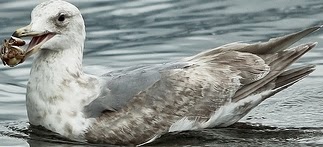In my last post, I cropped my gull picture so that I wouldn't have extra space on the sides.

Now, I need to shrink the puzzle to match the resolution of the final puzzle.In Paint.NET, I once again have the latest version of the picture loaded.
Resize can be found in the Image menu. I prefer to have the long side at 40 pixels. I set height or width, whichever is larger to 40. Before I do this, I make sure the box for maintain aspect ratio is checked. This keeps the picture from becoming distorted.
Puzzles are usually divisible by 5. Part of the reason for this is that it's nice to have thicker lines every five rows or columns to simplify counting. Not many people want to count 30 by ones. Setting the width to 40 gave me a height of 18. That won't work. I uncheck the maintain aspect ratio box and round to the nearest 5. This should keep me close in aspect ratio while also filling a puzzle with a size that works for me. In this particular case, that would be 20.
If the height would have been 17, I would have done things a little differently. I don't like dimensions lower than 20. Since the closest multiple of 5 to 17 is 15, I would have changed the width to 45. This would have allowed me to bring the height to 20 while staying close to the aspect ratio.

Previous: My Hanjie Process II
Next: My Hanjie Process IV
No comments:
Post a Comment